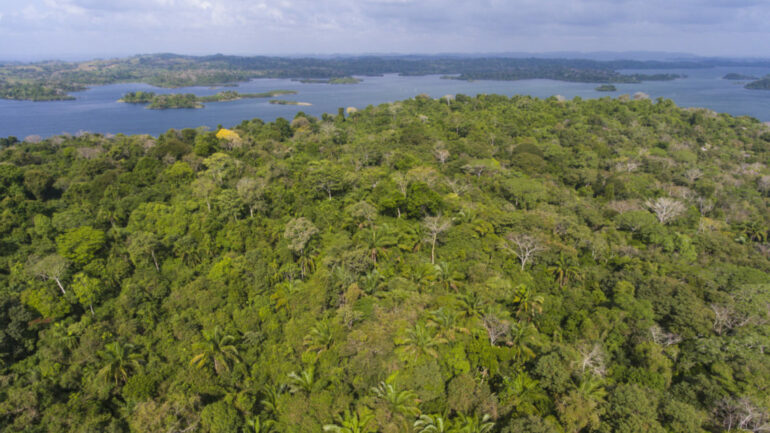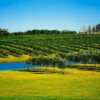Tropical forests are being cleared for agriculture and other uses at alarming rates.
While scientists say it is essential to protect old-growth forests and stop further deforestation, studies by an international team of tropical ecologists—including Clemson University professor Saara DeWalt—showed that naturally regrowing forests recover surprisingly fast and can play a role in climate change mitigation.
“Nature will take care of it if we let it,” said DeWalt, chair of the College of Science’s Department of Biological Sciences. “Restoration of tropical forests should rely on natural regeneration. It’s the most efficient way to do it. It’s the most ecologically efficient. It’s the most economically efficient.”
“The services that tropical forests provide are important not just to the people who live around them, but to the globe,” DeWalt continued. “We’re trying to keep the climate from changing, and one of the key ways we can do that is making sure that we’re taking up carbon dioxide and storing it rather than releasing it into the atmosphere.”
Tropical rainforests play a crucial role in the global ecosystem because they absorb carbon dioxide, a greenhouse gas that traps heat in our atmosphere. The more carbon dioxide in the atmosphere, the more pronounced the greenhouse effect and climate change could become.
Secondary forests regrow naturally after nearly complete removal of forest cover for anthropogenic use, usually for shifting cultivation, conventional cropping or cattle ranching. Currently, over half of the world’s tropical forests are not old growth but naturally regenerating forests, of which a large part is secondary forest. In the neotropics, secondary forests cover as much as 28 percent of the land area.
In a study published in the journal Science, the researchers analyzed how 12 forest attributes recover during the natural regeneration process and how their recovery is related. They studied 77 sites and 2,275 forest plots across tropical forests in North and South America and West Africa. DeWalt’s contributions came from plots she and her collaborators have been studying since the 1990s in central Panama.
They found that soil fertility takes less than 10 years to recover to old-growth forest values. Plant functioning takes less than 25 years, and species diversity takes 60 years. Above-ground biomass and species composition take over 120 years.
“While it is essential to actively protect old-growth forests and stop further deforestation, tropical forests have the potential to regrow naturally in already deforested areas on abandoned lands. These regrowing forests cover vast areas and can contribute to local and global targets for ecosystem restoration,” said Lourens Poorter, a professor at Wageningen University in the Netherlands and lead author of the study.
If the deforested area isn’t too big or farmed too much, a nearby forest could provide a nourishing and interconnected ecosystem necessary for a new forest to grow. But some circumstances require reforestation.
“If there’s no source for seeds, heavily degraded soils, and no way for animals to get there, that’s going to be a problem,” DeWalt said. “There will be times when planting will be necessary,” DeWalt said.
Another study in which DeWalt took part gives insight into the selection of tree species to enhance tropical forest restoration success.
The international team of researchers analyzed recovery in functional properties of 30 tropical forests across North and South America, using data from over 1,000 plots and 127,000 trees. They measured seven traits that are important for drought tolerance and productivity.
They found that dry and wet forests strongly differ initially in their functional composition, follow different successional pathways, but become more similar in functional characteristics as forests grow older.
Published in the Proceedings of the National Academy of Sciences, the study compared plots that differed in the time since land was abandoned and forests began to regrow, ranging from zero to 80 years ago.
The findings showed species turnover in dry forests was driven initially by traits that improve resistance to drought, such as smaller leaf size. In wet forests, traits associated with faster tree growth were most common initially. Later, features associated with faster growth and greater tolerance to the shaded conditions of these tall and closed-canopy forests drove species turnover.
“If we need to actively reforest, the functional traits of species could be simple indicators to know which species to plant,” DeWalt said.
For reforestation projects, the scientists recommend planting drought-tolerant species in dry forests and fast-growing species in wet forests.
“Preservation of old-growth forests is the gold-standard for forest conservation, but all of our studies show that allowing secondary forests to regrow—assisted or even unassisted—can be an important part of the toolkit for tropical forest conservation,” DeWalt said.
More information:
Lourens Poorter et al, Multidimensional tropical forest recovery, Science (2021). DOI: 10.1126/science.abh3629
Lourens Poorter et al, Functional recovery of secondary tropical forests, Proceedings of the National Academy of Sciences (2021). DOI: 10.1073/pnas.2003405118
Provided by
Clemson University
Citation:
Researchers: If left alone, tropical forests can recover on their own surprisingly fast (2022, February 8)



